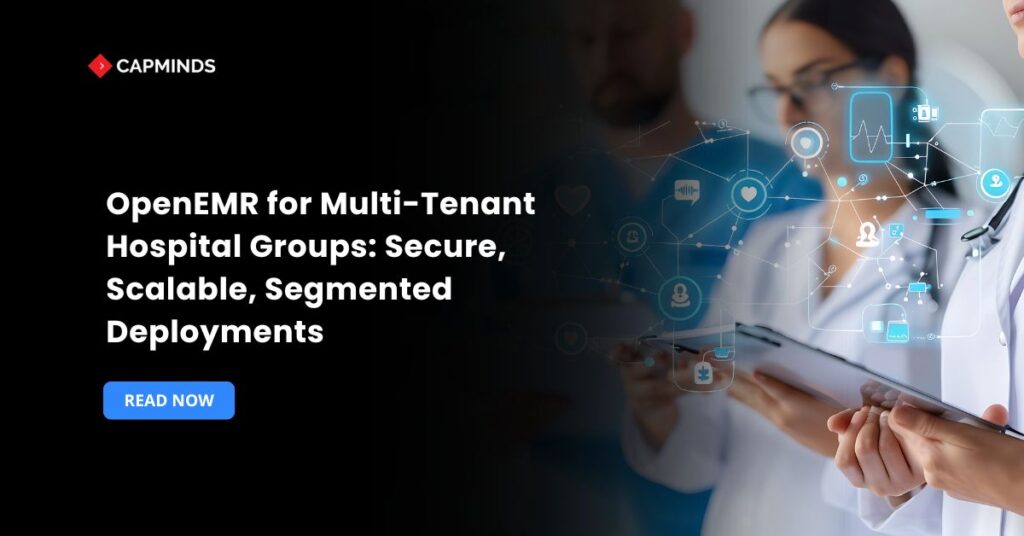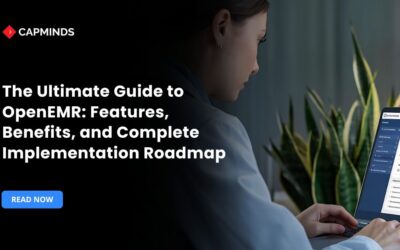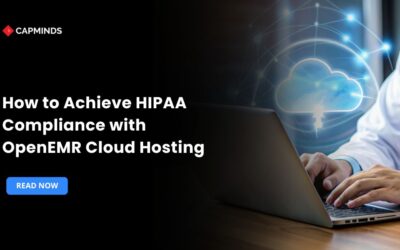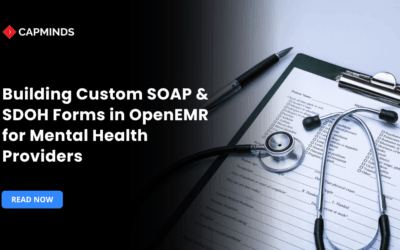OpenEMR for Multi-Tenant Hospital Groups: Secure, Scalable, Segmented Deployments
Hospital organizations expand through mergers, acquisitions, and regional expansions, resulting in increased demand for a multi-tenant EMR system. OpenEMR, the world’s most popular open-source, provides the flexibility and cost-effectiveness required to serve as the digital backbone for multi-tenant healthcare companies. Adopting OpenEMR across different hospitals or regions has new issues, including data segregation, security, scalability, and regulatory compliance.
This blog explains how OpenEMR can be optimized for multi-tenant, enterprise-grade installations, identifies important issues, and proposes best practices for implementation.
Why is a Multi-Tenant EMR Important for Hospital Groups?
A multi-tenant EMR is a single, centrally managed application that securely divides data and functionality per hospital or department. This unified method provides:
- Comprehensive patient visibility throughout the network.
- Scale-saving benefits of a unified IT infrastructure.
- Standardized processes and reporting, while retaining local autonomy.
OpenEMR’s modular architecture and robust permission model make it ideal for segmented, multi‑tenant deployments. Modern hospital networks can include hundreds of distinct hospitals and specializations. Managing each location in a distinct EMR instance results,
- Fragmented patient records lead to gaps in clinical data and care coordination.
- Increasing operating expenses, as each instance requires its hardware and licensing.
- Inconsistent processes, training, and reporting among facilities.
Advantages of OpenEMR for Multi-Tenant Setup
1. Cost-Effective and Predictable TCO
An open-source license allows hospitals to reduce software expenses per seat or facility. A common infrastructure, paired with containerization or virtualization, facilitates scalability while lowering hardware, license, and maintenance costs.
2. Customization and Extensibility
OpenEMR’s plugin design, API compatibility including FHIR and HL7, and PHP-based codebase allow for quick creation of particular modules, patient portals, and integrations that suit a hospital’s operations, all within a shared core.
3. Centralized Governance and Localized Control
Administrators may control which providers and employees can read and act on tenant data by using facility-scoped user groups and role-based access limitations. Central management over policies, updates, and security patches may ensure uniformity and compliance.
4. Community-Backed Security and Innovation
With thousands of contributors throughout the globe, OpenEMR experiences ongoing evaluation, security audits, and updates, which reassure business users about the platform’s direction and stability.
Related: Achieving Interoperability at Scale: HL7, FHIR, and API Integrations with OpenEMR
Challenges for Multi-Tenant Deployments
1. Data Segregation and Privacy
Ensuring that PHI is completely segregated across hospitals is critical. Misconfigurations in database schemas or application-layer filters might unintentionally expose patient information across tenancy borders.
2. Performance and Resource Management
Supporting various hospitals in a single instance necessitates meticulous capacity planning. Without effective resource allocation, such as CPU, memory, and I/O, a single tenant’s peak utilization might impact the experience for all users.
3. Compliance Across Countries
Hospital groups that span numerous states or countries must comply with a variety of standards, including HIPAA, GDPR, and local privacy regulations. Ensuring that data residency, audit trails, and breach reporting protocols fulfill each jurisdiction’s laws can be difficult.
4. Upgrade Coordination and Customization Conflicts
Upgrades to the main OpenEMR platform can become complex when each tenant demands unique changes, such as customized billing procedures or connections. Thorough testing is necessary to ensure that patches or new versions do not cause tenant-specific module issues.
Implementing a Secure and Scalable Multi-Tenant OpenEMR
1. Architecture Overview
Containerized Deployment
- Use Docker or Kubernetes to encapsulate the OpenEMR application and its dependencies.
- Use namespaces or different pods for common services (e.g., database and authentication) vs tenant-specific microservices.
Database Segmentation
- Create a distinct schema for each hospital within a shared database instance.
- To provide maximum isolation, create distinct database instances for each tenant using a shared proxy layer.
Unified Authentication and SSO
Integrate OpenEMR with a corporate identity provider such as Active Directory or Okta via SAML or OAuth2. Enforce MFA for protected accounts.
API Gateway & Service Mesh
- Route tenant-scoped API requests through an API gateway for rate limitation, request validation, and tenant identity.
- Use a service mesh to provide secure communication and observability between services.
2. Security Hardening
Encrypted Data at Rest and in Transit
- Enable full-disk encryption for the database servers.
- Use TLS 1.2 or higher for all client-server and inter-service connections.
Least-Privilege Access Controls
- Create granular roles like clinician, nurse, biller, and assign them tenant-specific access.
- Automate user provisioning and de-provisioning using SCIM or LDAP.
Continuous Vulnerability Scanning
Integrate security scanners such as Clair and Anchor into your CI/CD process to detect outdated libraries or misconfigurations.
Audit Logging and Monitoring
- Centralize logs like application, database, and infrastructure in a SIEM such as ELK.
- Set up real-time warnings for suspect access patterns or policy infractions.
3. Testing and Quality Assurance
- Automated integration tests cross-tenant activities and ensure data isolation. Runs upgrade tests using tenant-specific custom modules.
- Performance benchmarking uses load-testing tools to simulate concurrent users by tenancy.
- Update resource quotas and auto-scaling settings depending on test findings.
Best Practices for Multi-Tenant Deployments
- Strong Tenant Isolation – Each tenant has its own schema/instance and network namespace.
- Infrastructure as Code – Provide and version your clusters, networks, and storage.
- Centralized Identity and RBAC – Integrate SSO/MFA and assign tenant-specific least-privileged roles.
- Automated, Tenant-aware CI/CD – Include security scans and smoke tests for a canary tenant before wider distribution.
- Per-tenant Monitoring and Quotas – Tag metrics/logs by tenant, and impose CPU/memory restrictions to avoid noisy neighbors problems.
- End-to-end Encryption and Auditing – TLS and disk encryption, tenant-specific key management, and extensive audit trails.
- Automated Onboarding and DR – Schedule tenant provisioning/offboarding, retention policies, backups, and failover exercises.
Related: Scaling OpenEMR for Multi-State Health Systems: Architecture, Compliance, and Customization Guide
CapMinds OpenEMR Customization and Integration Service
CapMinds OpenEMR equips clinicians with the best features and ways to integrate. It makes their workflows more efficient and filtered.
The integrated features will allow them to combine the ability of patient record management with conceptual and concurrent reminders.
This enhances the process of decision-making and improves patient care and quality.
- At CapMinds, OpenEMR custom solutions are developed with much care and accuracy to match the special practice needs.
- It will be low-cost and the perfect budget solution for your practice’s long-term future.
- CapMinds OpenEMR prioritizes secure data management & ensures compliance with industry regulations, offering healthcare providers peace of mind.
Get the best technologies and HIPAA-compliant and efficient OpenEMR from CapMinds that can be tailored to fit your practice.
Our OpenEMR services facilitate a Modern User Interface (UI), customization, production support, and training. They also facilitate billing, reporting, specialty enhancements, clearing house integrations, e-prescribing, and cloud services.
“Get the most experienced, proven, and perfect professional support for your OpenEMR.”




